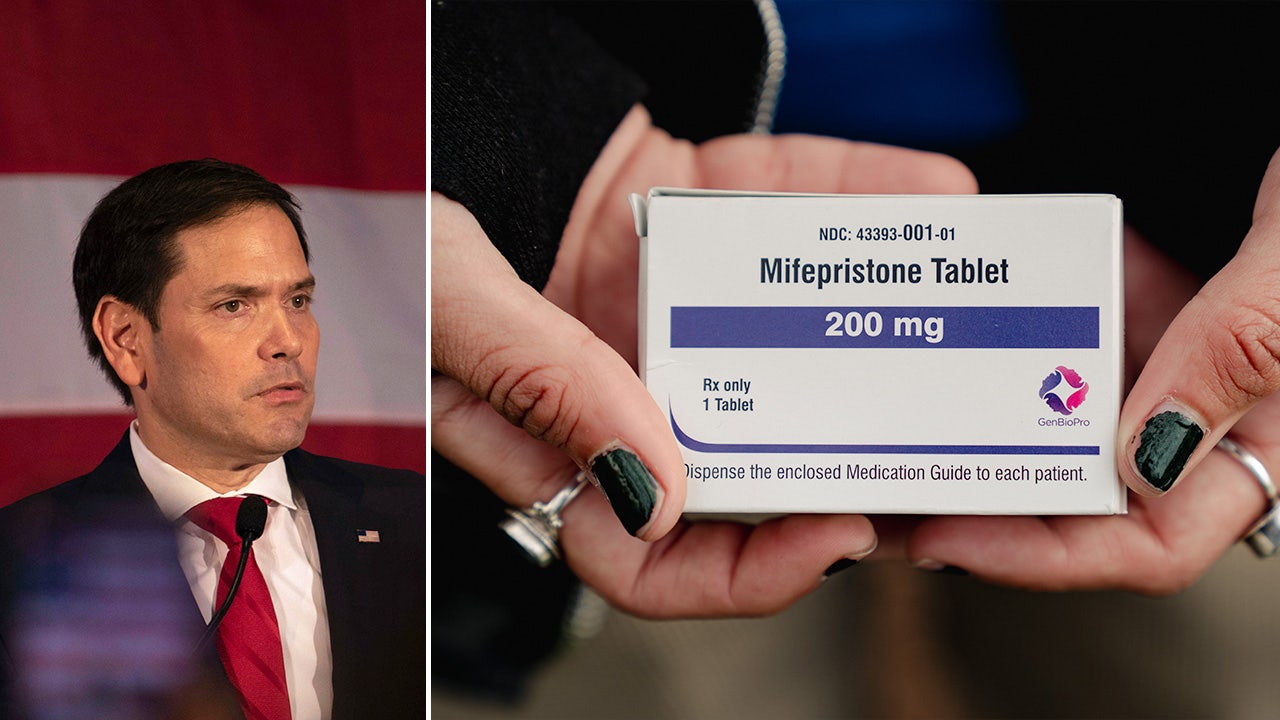Health
Woman’s life is saved when full-body scan detects deadly condition with no symptoms
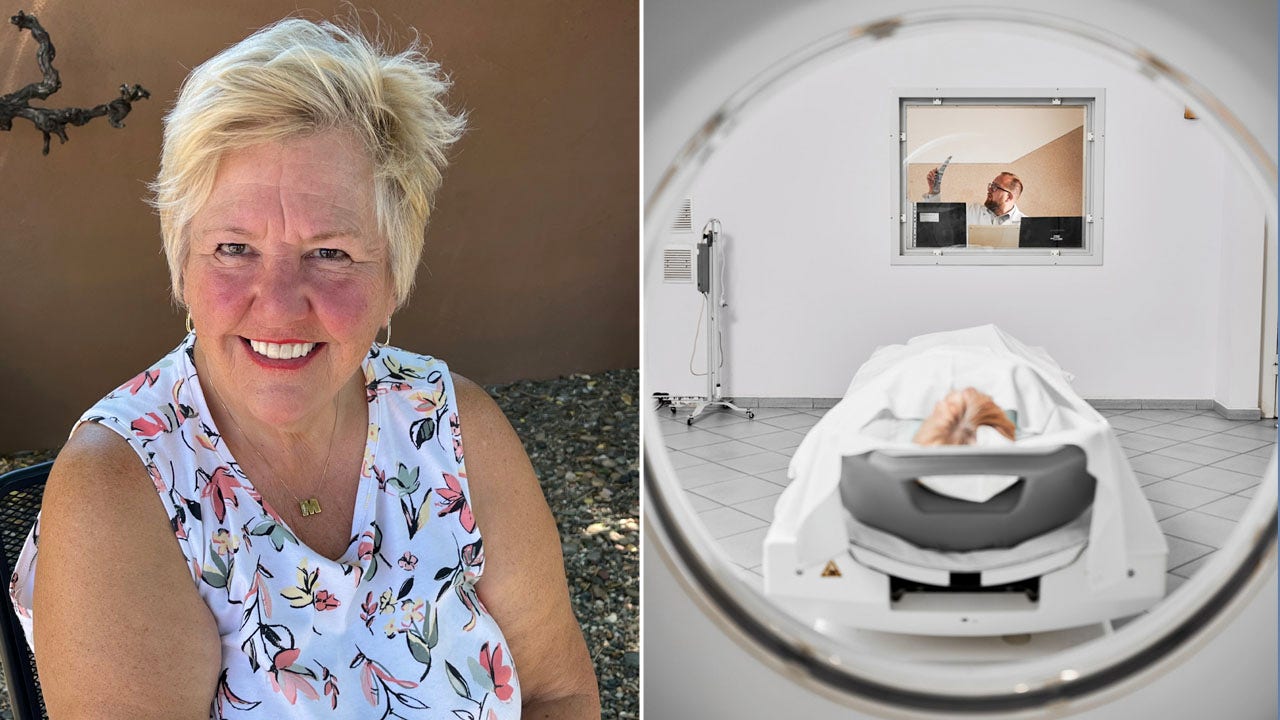
As some doctors say, “If you look, you will find.”
In August 2023, Mary Ann Waldron, a healthy Arizona woman, decided to undergo an elective MRI full-body scan at a SimonMed Imaging facility, never expecting to find anything serious.
She was shocked when the scan detected a large aneurysm in her pancreas area, ultimately saving her life.
THESE 8 HEALTH SCREENINGS SHOULD BE ON YOUR CALENDAR FOR 2024, ACCORDING TO DOCTORS
Today, a strong proponent of full-body scans as a preventative measure, Waldron is eager to share her story as a cautionary tale for others.
“I believe we each need to take responsibility for our health,” she told Fox News Digital. “I’m more than 70 years old, and despite being asymptomatic, I wanted to learn if I had any early-stage cancers.”
Mary Ann Waldron, 73, pictured with her husband, had a life-saving MRI that detected a potentially deadly aneurysm. (Mary Ann Waldron)
Dr. Brett Osborn, a Florida neurologist and longevity expert, also recognizes the benefits of full-body MRI scans.
“Full-body scanning, mainly through MRI, presents a significant advancement in modern medicine’s diagnostic capabilities,” he told Fox News Digital. (He was not involved in Waldron’s care.)
CANCER SCREENINGS: HERE ARE 5 TYPES AND CRITICAL INFORMATION TO KNOW ABOUT EACH
“MRI technology allows for a comprehensive, noninvasive examination of the body to detect a wide range of conditions, including cancer and vascular malformations like aneurysms, without the need for potentially harmful X-rays, as is the case with CT scans.”
Life-saving discovery
The results of Waldron’s scan indicated that there “may be an aneurysm.” A follow-up CT scan of her abdomen and pancreas was then recommended.
“If in fact I had an aneurysm, then this was life-threatening, as death is imminent when an aneurysm bursts, unless the person is already in an operating suite,” said Waldron.

“Full-body scanning, mainly through MRI, presents a significant advancement in modern medicine’s diagnostic capabilities,” a doctor told Fox News Digital. (SimonMed)
Dr. Barry Sadegi, SimonMed’s chief medical officer in Scottsdale, Arizona, emphasized the danger of Waldron’s condition.
“Pancreaticoduodenal artery aneurysms are extremely rare, representing only 2% of all splanchnic (abdominal organ) aneurysms,” he told Fox News Digital.
“The majority (64%) of patients who seek treatment present after the aneurysm has ruptured.”
Aneurysm rupture can be life-threatening, Sadegi confirmed, as it results in abdominal bleeding.
KIM KARDASHIAN SAYS FULL-BODY MRI SCANS CAN BE ‘LIFE-SAVING,’ YET MANY EXPERTS REMAIN SKEPTICAL
In many cases, there are no symptoms of an aneurysm, which was the case for Waldron.
“And because I had no prior imaging studies of this area for comparison, there was no way to know how long this aneurysm had been present or for how much longer it would exist before bursting,” she added.
Once doctors confirmed that Waldron had an aneurysm, she was referred to a vascular surgeon, who determined that she would need immediate surgery.
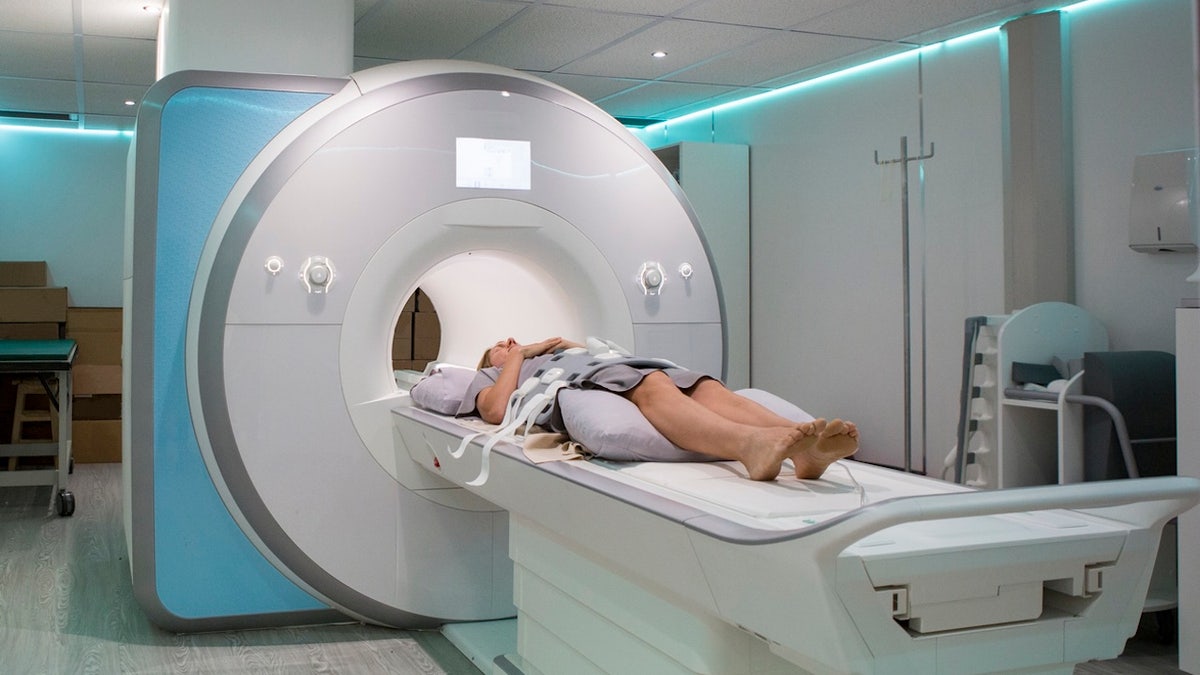
Because the MRI scans don’t use ionizing radiation, the test itself is safe, said Sadegi of SimonMed, although the test does have some indirect risks and limitations. (iStock)
“We scheduled the procedure and were advised to drive from Sedona to Chicago, as the risk of flying with changes in pressure was dangerous,” she said. “The size and location of my aneurysm was unusually large and uncommon.”
Waldron underwent an angiogram of the mesenteric artery (a major artery of the abdomen). The surgeon performed an embolization of the aneurysm, placing several titanium wires to block the artery and close off the sac of the aneurysm, preventing further blood flow and bursting.
Today, Waldron is feeling healthy and is back to her regular routines.
AI TECHNOLOGY CATCHES CANCER BEFORE SYMPTOMS WITH EZRA, A FULL-BODY MRI SCANNER
“It is now necessary for me to take daily blood thinners, which make me susceptible to bruising, but other than that I am feeling well,” she told Fox News Digital.
“I have resumed my usual activities of golf, swimming and walking.”
Waldron will continue to see her doctor every six months for the next couple of years for ultrasounds of the stented area.

The SimonONE scan (pictured) scans the entire body for warning signs of disease without using ionizing radiation. (SimonMed)
“This was a truly life-saving surgery,” she said.
“Generally, early detection enables early intervention, which provides the best opportunity for successful resolution. In my case, the detection was not early in the formation of the aneurysm, but was early enough to correct it.”
She added, “I believe these scans can detect abnormalities at an early stage, helping us prolong our lives — and certainly the quality of our lives.”
Focus on preventative health care
The majority of the U.S. health care system is reactive rather than proactive, Sadegi stated — “more focused on treating illness after it develops rather than preventing it.”
The scan, he said, is a means of empowering patients who want to take an active role in their disease prevention.
CANCER PREVENTION IN THE ESOPHAGUS COULD BE JUST A PILL AWAY, DOCTOR SAYS: ‘TREMENDOUS BENEFIT’
“Although the American College of Radiology does not currently recommend MRI whole-body screening for the general population, many SimonONE patients have similar stories in which the scan resulted in very positive health outcomes,” he said.

“Because there can be false positives, one may argue that there is unnecessary expense in the whole-body scan and unnecessary radiation in the follow-up studies that confirm there are no issues,” Waldron, pictured, told Fox News Digital. (Mary Ann Waldron)
Some of the conditions that SimonMed’s scans have discovered have included other aneurysms, severe arterial stenoses in the neck and head, and masses in the brain, pituitary gland, neck, thyroid, mediastinum, lungs, liver, pancreas, kidneys, lymph nodes, bladder, endometrium and prostate gland, said Sadegi.
Potential risks and limitations
Because the MRI scans don’t use ionizing radiation, Sadegi said the test itself is low-risk.
There is the risk of overdiagnosis, however, as Osborn noted.
“This is where benign conditions are detected and treated unnecessarily, leading to undue stress, further testing, and potentially unnecessary interventions and their inevitable complications,” he told Fox News Digital.

Today, Waldron is feeling healthy and is back to her regular routines. “This was a truly life-saving surgery,” she said. (Mary Ann Waldron / iStock)
“These studies are imperfect,” he told Fox News Digital. “Is the patient ready to deal with a positive finding? Often, it’s unclear whether a lesion is benign or malignant. And then what? Are these studies worth the ‘risk’ at this point?”
He added, “I defer to my patients and allow them to make an informed decision. To me, however, the benefits far outweigh the risks.”
NEW BREAST CANCER SCREENING GUIDELINES CALL FOR WOMEN TO START MAMMOGRAMS AT AGE 40
In Waldron’s case, she was OK with the risks.
“Because there can be false positives, one may argue that there is unnecessary expense in the whole-body scan and unnecessary radiation in the follow-up studies that confirm there are no issues,” she said.
“I defer to my patients and allow them to make an informed decision. To me, however, the benefits far outweigh the risks.”
“But this, in my opinion, is a minor trade-off for the peace of mind one achieves either knowing all is well or knowing what needs to be addressed.”
This type of scan also has some limitations.
It does not screen for blood-borne tumors, such as leukemia, or for skin tumors, such as melanoma or basal cell carcinoma, according to Sadegi. It also might not detect smaller nodules in the lungs.
CLICK HERE TO SIGN UP FOR OUR HEALTH NEWSLETTER
The scan is also not ideal for detecting musculoskeletal conditions involving bones or joints.
Sadegi said it cannot replace colonoscopies for colon or rectal screenings; and mammography and MRI of the breasts are more sensitive for breast cancer.
Barriers to care
Right now, given the associated costs, most insurance carriers do not cover a full-body MRI, Osborn pointed out.
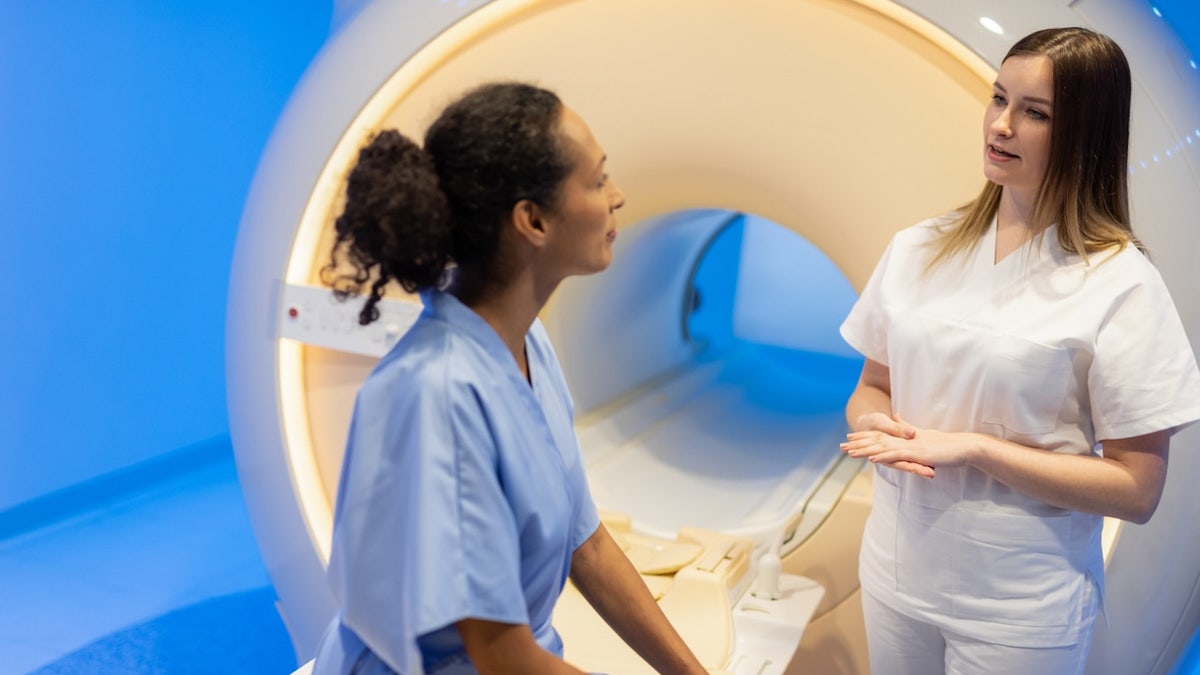
“These scans can detect abnormalities at an early stage, helping us prolong our lives and certainly the quality of our lives,” said one patient. (iStock)
“The numbers don’t make sense to them,” he said. “It’s simply a matter of dollars and cents. Many scans, at significant cost, would have to be performed to save one life … This is the ‘business’ of medicine and one of the main reasons why, historically speaking, insurance companies have not embraced preventive care.”
That could change in the future, he said.
“As consumer interest in preventive care soars — and people want to live longer, healthier lives — it may be the driver of change.”
For more Health articles, visit www.foxnews.com/health.

Health
FDA warns that nicotine-like chemicals in vapes may be more potent than nicotine

- Nicotine alternatives like 6-methyl nicotine in vapes may be more addictive than nicotine, according to the FDA.
- These synthetic substances are not regulated by U.S. tobacco and vaping laws that control traditional nicotine.
- Traditional nicotine is derived from tobacco leaves, while 6-methyl nicotine is synthesized in labs using chemicals.
Nicotine alternatives used in vapes being launched in the U.S. and abroad, such as 6-methyl nicotine, may be more potent and addictive than nicotine itself, though the scientific data remains incomplete, according to the U.S. Food and Drug Administration (FDA) and independent researchers.
The synthetic substances – which have a chemical structure similar to that of nicotine – are not subject to U.S. tobacco and vaping regulations that are designed to control traditional nicotine, a highly addictive drug.
That means manufacturers can sell vapes containing synthetic nicotine analogues such as 6-methyl nicotine in the United States without seeking authorization from the FDA – a process that can be costly, time-consuming and is often unsuccessful.
YOUNG VAPER WHO REQUIRED DOUBLE LUNG TRANSPLANT SHARES WARNINGS AS E-CIGARETTE SALES RISE
Big tobacco firms like Altria Group and British American Tobacco have already lost substantial U.S. sales to an influx of disposable vapes containing traditional nicotine that are being illegally sold without FDA authorization.
Various vapes, nicotine products and the new Spree Bar, which contains a chemical that mimics nicotine, line the shelves at Sultans’ Smoke in Arvada, Colorado, on May 21, 2024. (REUTERS/Kevin Mohatt/ File Photo)
Altria, the maker of Marlboro cigarettes in the United States, highlighted the emerging use of 6-methyl nicotine in vapes and other smoking alternatives in a May 9 letter to the FDA, according to a copy of the correspondence posted on its website.
It urged the agency to evaluate the compounds and establish what authority it had over them, warning they posed a “new threat” to regulation of the sector.
“The introduction and growth of chemicals intended to imitate the effects of nicotine, if left unchecked, could present unknown risks to U.S. consumers and undermine FDA’s authority,” the letter said.
SMOKING CIGARETTES CAN DESTROY LUNGS, BUT SHOCKING NEW STUDY REVEALS WHY VAPING CAN HARM THE HEART
It cited SPREE BAR, a vape launched in October by Charlie’s Holdings Inc that uses 6-methyl nicotine.
The FDA does not comment on its correspondence with individual firms.
In response to Reuters’ questions about 6-methyl nicotine and other nicotine alternatives, the FDA said in a statement: “Although more research is needed, some emerging data show these nicotine analogs may be more potent than nicotine – which is already highly addictive, can alter adolescent brain development and have long-term effects on youth’s attention, learning and memory.”
Traditional nicotine found in many vapes and pouches is extracted from tobacco leaves. 6-methyl nicotine, in contrast, is made entirely in the lab using chemicals.
The FDA said it was considering the use of such synthetic compounds from an “agency-wide perspective” and would use all of its resources to protect youth from products that may harm their health. As well as tobacco products, the FDA also regulates drugs, foods, cosmetics and more to ensure safety and efficacy.
“The FDA is a data-driven agency, and we’re in the process of reviewing the available data to inform potential actions in this space,” it said in response to Reuters’ questions.
Three academic researchers told the news agency that current studies of 6-methyl nicotine are too limited to draw definite conclusions on the health impact or to what degree it is addictive.
Imad Damaj, a professor in the Department of Pharmacology and Toxicology at Virginia Commonwealth University, said his research showed 6-methyl nicotine may be more potent than nicotine, but more extensive tests were needed to say what impact it has on humans.
The limitations of existing research included that some papers were industry funded, while others focused on the short-term impact on animals or cells and were insufficient to understand 6-methyl nicotine’s effects on human bodies, the researchers said.
Charlie’s Holdings calls the 6-methyl nicotine solution used in SPREE BAR Metatine. SPREE BAR’s website says Metatine “may have a toxicity profile similar to nicotine”.
SPREE BAR promises users 6,000 puffs from each device and offers fruity flavors including “blue razz ice” and “creamy melon”, according to its website.
The FDA has yet to approve any flavored vape using traditional nicotine for sale in the United States, saying companies have not been able to show that the health benefits they offer to smokers outweigh the known risks to young people, who may be more attracted by the flavors.
Charlie’s Holdings co-founder Ryan Stump told Reuters that the company only targets adults, adding that flavors played an important role in its mission to help smokers quit cigarettes.
Stump said Charlie’s Holdings respects and abides by laws in every market where it operates. He acknowledged that more research is needed on 6-methyl nicotine, adding that the company dilutes it in its products.
US SCHOOLS INVEST MILLIONS IN SURVEILLANCE TECHNOLOGY TO COMBAT TEEN VAPING EPIDEMIC
TARGETING INTERNATIONAL MARKETS
Anes Saleh sells SPREE BAR in his vape shop in Denver, Colorado, called Sultan Smoke. He said he has some customers who only buy Spree Bar instead of a nicotine vape and he hasn’t had any negative feedback on the product.
“The only… protest I would hear about people not wanting to try this is that they don’t know what Metatine is or does,” he said.
Stump said that Charlie’s Holdings is working on new varieties of SPREE BAR and new products using 6-methyl nicotine. It will launch SPREE BAR internationally this year. He declined to say where.
The company buys the 6-methyl nicotine solution used in SPREE BAR from another U.S. firm, Novel Compounds, according to Novel Compounds’ founder Samuel Benaim.
Novel Compounds imports 6-methyl nicotine from overseas and alters it to make it easier for manufacturers like Charlie’s Holdings to use in their products. It sells this solution under the trade name imotine.
Tests commissioned by Novel Compounds have found 6-methyl nicotine to be no more harmful than nicotine, Benaim said. But he also said that more research was needed into the chemical.
Benaim added that Novel Compounds had received legal advice that its product is not classified as a tobacco product or drug in the United States. The company is committed to legal compliance, he said.
MORE POTENT THAN NICOTINE?
Sven Jordt, a professor at Duke University, who has authored papers on products like SPREE BAR, said 6-methyl nicotine could me more addictive and toxic than its traditional cousin.
“Do we want to have such a chemical as a recreational product, available to anyone?,” he asked. “That’s really questionable.”
Neither Jordt nor Damaj – the professor at Virginia Commonwealth University – have received funding from tobacco or vape makers.
As well as the United States, Novel Compounds also sells its 6-methyl nicotine solution around the world, including in the United Kingdom, Indonesia, India and Japan.
Another company, Aroma King, sells 6-methyl nicotine in the United Kingdom in pouches, which users insert under the lip to get a buzz. The pouches are sold in cans emblazoned with graphics of gorillas in suits and sunglasses.
It said in a February blog post that its 6-methyl nicotine products were “less toxic”, “less harmful”, and “less addictive” than regular nicotine products.
In a statement to Reuters, Aroma King cited existing research, its own toxicology and other tests and its supplier, which classifies 6-methyl nicotine as less toxic under the European Union’s Classification, Labelling and Packaging of Substances and Mixtures (CLP) Regulation.
Aroma King said 6-methyl nicotine was self-classified by its supplier. It declined to say who supplies it with the chemical.
Four Chinese companies hold patents in China related to the production of 6-methyl nicotine, including Zinwi Biotech, a company that makes the liquid used in vapes.
Zinwi Biotech confirmed it is researching 6-methyl nicotine but did not answer further questions, including on whether it has sold any 6-methyl nicotine so far. Reuters was unable to find contact details for the other firms.
Health
Michigan mom: ‘I had a stroke at 39 — and the warning signs weren’t what you’d expect’
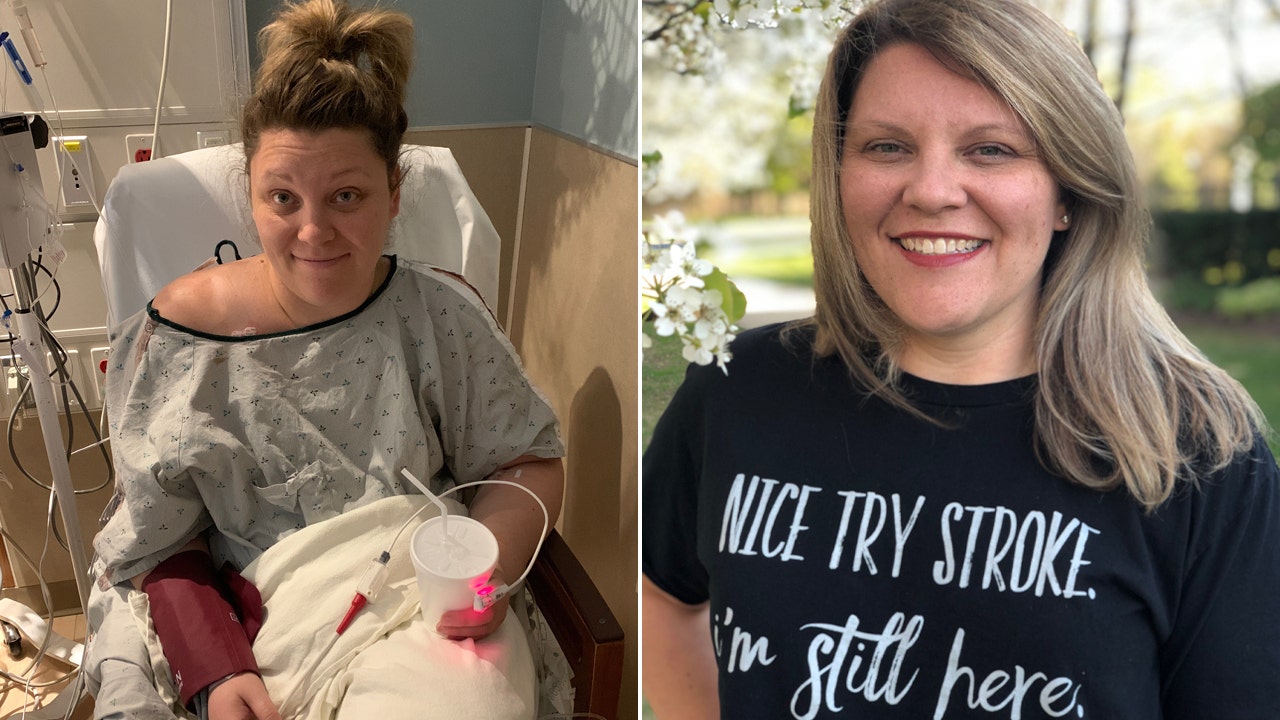
Jenna Gibson was just 39 when she was training for a marathon five years ago — but her plans were cut short by a stroke that almost took her life.
Nearly 60% of stroke deaths occur in women, according to a recent study by Mayo Clinic — and now Gibson, a Michigan mother of two, aims to help others to be more aware and prioritize their health.
“Once I learned that strokes are happening to younger people, I had to share my story,” she told Fox News Digital.
5 WOMEN’S HEALTH TIPS TO PREVENT AND DETECT STROKES, ACCORDING TO CARDIOLOGISTS
“In most cases, strokes are preventable if you know what to look for.”
On the day of Gibson’s stroke, she was feeling great.
Jenna Gibson was just 39 years old when she was training for a marathon five years ago — but her plans were cut short by a stroke that nearly took her life. (Jenna Gibson)
It was a beautiful day, she’d nailed a presentation at work, and she was enjoying a walk outside with her mother after dinner.
“We were talking about how I was training for the Detroit marathon for my 40th birthday, and then all of a sudden, out of the blue, it felt like I was hit with a ton of bricks,” she told Fox News Digital.
DOG ALERTS FAMILY, SAVES TEXAS TEENAGER FROM LIFE-THREATENING STROKE: ‘KEEPING GUARD’
Gibson stopped walking, then suddenly fell over into the grass.
Her mother thought she was joking at first. “She actually took a picture of me lying in the grass, saying, ‘C’mon, get up, what are you doing?’”
“They could see there was a blockage on the left side of my brain, and I was actively having a stroke.”
Her mother helped her up, but Gibson couldn’t walk straight.
“I felt like I was drunk — something just wasn’t right,” she said.
Even so, Gibson did not experience any of the textbook symptoms of a stroke, such as the facial droop, severe headache or vision disturbances.

When Gibson first fell onto the grass, her mother thought she was joking — and snapped this picture. As it turned out, Gibson was in the early stages of having a stroke. (Jenna Gibson)
They made it back home, where Gibson assumed she was having a migraine. She took some headache medicine and went to bed.
“A couple of hours later, I woke up and still didn’t feel right — I couldn’t get out of bed, I couldn’t move,” she recalled.
TIAS AND MINI-STROKE RISKS: CARDIOLOGIST SHARES WARNING SIGNS AND PREVENTION TIPS
That’s when they headed to the emergency room. Gibson’s mother told the medical team that her daughter was having trouble walking and might be having a stroke.
“They checked me over, did all the tests, and didn’t see the typical signs that they would be looking for,” Gibson said. “Part of it was because I was young.”
“I could walk, although not very well. I could get some words out.”
She added, “I didn’t have the facial droop. I could walk, although not very well. I could get some words out.”
After a CT scan, the medical team decided that Gibson was likely having an optic migraine. The next morning, when she still wasn’t feeling right, the neurologist ordered another scan with contrast — and that time, the stroke finally showed up.

Gibson is pictured with her husband and two daughters, who were ages 8 and 4 at the time of her stroke in 2019. (Jenna Gibson)
“They could see that there was a blockage on the left side of my brain, and I was actively having a stroke,” she said.
Gibson was immediately airlifted to another hospital, where she had emergency brain surgery to remove the blood clot.
“There was obviously a risk of death — if we didn’t move fast enough, the time frame would be over,” she said.
HIGH BLOOD PRESSURE A CONCERN WORLDWIDE, LEADING TO DEATH, STROKE, HEART ATTACK: HOW TO STOP A ‘SILENT KILLER’
As she was flown to the hospital, Gibson said she felt certain she was going to die and would never again see her husband or her daughters, who were just 8 and 4 at the time.
“I thought I’d never get to see my children grow up and get married, or that I’d have to live in some kind of vegetative state and would never work again.”
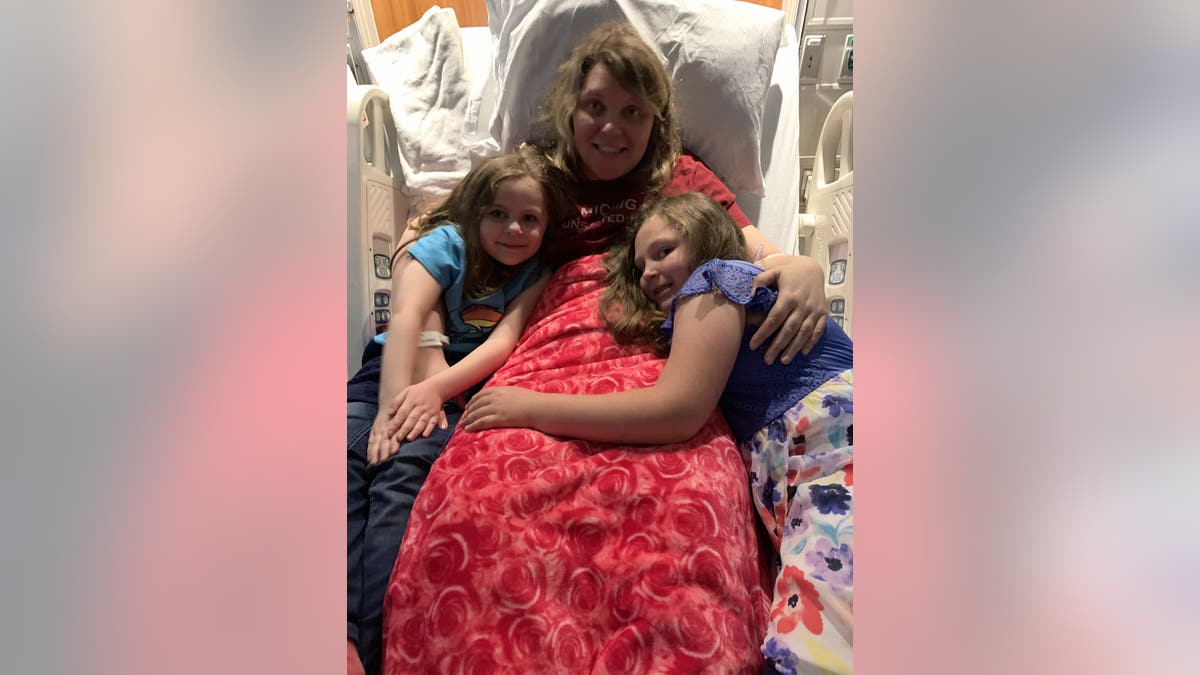
Gibson is pictured with her two daughters in the hospital after her stroke. Her first “assignment” was to tell her daughters that she loved them — and that “Mommy’s going to be OK.” (Jenna Gibson)
“I was thinking, ‘Did I tell my girls enough times that Mommy loves them? Does my husband know how proud I am of him?’”
The next thing she knew, Gibson was waking up from surgery in the ICU — and facing a long road to recovery.
“At first, I couldn’t speak at all. I couldn’t move my right side. I was trapped in my head — I could see what was happening and hear people asking me questions, but I couldn’t answer.”
‘By the grace of God’
Over the next few days, Gibson said her capabilities slowly started coming back.
She received speech therapy, occupational therapy and physical therapy — and over time began to regain movement on her right side.
REPORTS REVEAL THE RISK FOR STROKES IS ON THE RISE IN YOUNG ADULTS
Her first “assignment” was to tell her daughters that she loved them and that “Mommy’s going to be OK.”
After a couple of weeks, Gibson returned home and continued with outpatient therapy for three hours a day, three days a week for a four-month period.
“It was during the first six weeks that we saw the quickest improvement, and then after that, it was slower and slower,” she said.
“I had to relearn everything. And now, by the grace of God, I can do all the things.”
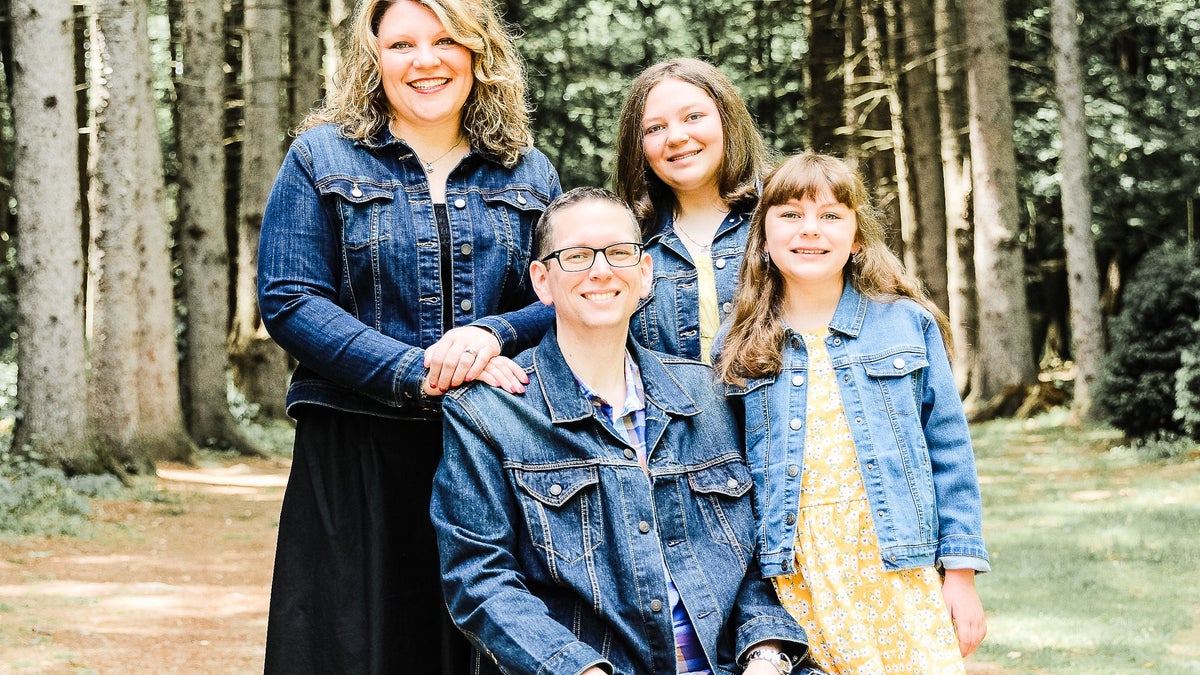
“I was thinking, ‘Did I tell my girls enough times that Mommy loves them? Does my husband know how proud I am of him?’” Gibson said about her stroke. She is pictured here with her husband and two daughters. (Jenna Gibson)
Today, Gibson is still completely numb on the entire right side of her body. She also still sometimes struggles with finding the right words while speaking, she said, especially when she’s tired or stressed.
“But if you saw me, I look like a normal person,” she said.
And in a full-circle moment, Gibson was finally able to complete the half-marathon last October.
‘Every second counts’
Dr. Annie Tsui, chief of neurology at Access TeleCare, who is based in Texas, emphasized the prevalence of strokes among women and urged awareness.
“Strokes can occur for various reasons across different age groups and genders,” Tsui, who was not involved in Gibson’s care, told Fox News Digital. “Even though strokes can occur at any age, women between the ages of 20 and 39 are at twice the risk compared to men.”
While the primary risk factors for stroke are high blood pressure, high cholesterol, heart disease, obesity and diabetes, the causes for strokes in younger age groups differ from those typically associated with older people, Tsui noted.

After her stroke was diagnosed, Gibson was airlifted to another hospital to get emergency brain surgery. (Jenna Gibson)
Those may include cardiac issues, blood clotting disorders, genetic predispositions, vascular abnormalities or trauma.
“Although no one is completely immune to the risk of stroke, individuals at higher risk should work with their doctor to develop a prevention plan,” Tsui advised. “In general, maintaining a healthy lifestyle is crucial, as up to 80% of strokes can be prevented.”
CLICK HERE TO SIGN UP FOR OUR HEALTH NEWSLETTER
It’s crucial to be aware of the symptoms to receive treatment as quickly as possible, according to Tsui.
She recommends using the FAST acronym, shown below, as a convenient tool for identifying stroke indicators.
- Face (drooping or numbness)
- Arm (weakness or numbness)
- Speech (slurring or difficulty speaking)
- T for time to call 911

Gibson underwent four months of intensive physical and occupational therapy during her recovery. (Jenna Gibson)
“The chances of survival and positive outcomes are highest when the patient receives prompt medical attention,” Tsui told Fox News Digital.
Some stroke treatments are only effective if administered within three hours of when symptoms begin, she warned — with the risk of permanent brain damage or death rising with each passing minute.
“It’s important to be vigilant in recognizing stroke symptoms and to seek medical assistance immediately at the first sign,” Tsui said.
“Every second counts in reducing the risk of brain injury, permanent disability or even death.”
For more Health articles, visit www.foxnews.com/health.
Health
Feeding peanuts to babies could prevent allergies through the teen years, study finds

Feeding peanut butter to babies — starting during infancy and continuing until age 5 — has been shown effective in reducing allergies into adolescence, according to a new study by King’s College London.
The LEAP-Trio study, published on Tuesday in NEJM Evidence, showed that children who consumed peanuts early in life were 71% less likely to develop peanut allergies all the way up to 13 years of age.
This was a follow-up to the Learning Early About Peanut Allergy (LEAP) clinical trial. The National Institute of Allergy and Infectious Diseases (NIAID) sponsored and co-funded both studies.
10 SURPRISING FACTS ABOUT PEANUT ALLERGIES, ACCORDING TO A PEDIATRIC IMMUNOLOGIST
In the original trial, half the participants were asked to consume peanuts regularly from infancy until age 5, while the other half were asked to avoid the food during that period.
Researchers found that early introduction of peanuts reduced the risk of peanut allergy at age 5 by 81%.
Feeding peanut butter to babies has shown to be effective in reducing allergies into adolescence, according to a new study. (iStock)
This latest trial included 508 participants from the original study, averaging 13 years of age.
The children were given peanuts in a “carefully controlled setting” to gauge any allergic reactions.
Peanut allergies were “significantly more prevalent” among the children who avoided peanuts in the first five years of life.
BABY SLEEP DANGERS REVEALED IN NEW STUDY AS NEARLY 70% OF INFANT DEATHS WERE DUE TO CO-SLEEPING
“Regular, early peanut consumption reduced the risk of peanut allergy in adolescence by 71% compared to early peanut avoidance,” the study authors wrote.
This effect persisted regardless of whether the children had eaten peanuts regularly or avoided them over a period of many years.
FDA APPROVES ALLERGY DRUG TO LESSEN SEVERITY OF REACTIONS TO PEANUTS, DAIRY, OTHER FOODS
“The key finding of this study is that early consumption of peanut, starting early in the first year of life, confers long-term protection against peanut allergy all the way into adolescence, even without continued consumption of peanut beyond the age of five years,” lead study investigator Gideon Lack, a professor at King’s College London, told Fox News Digital.

Children who consumed peanuts early in life were 71% less likely to develop peanut allergies all the way up to 13 years of age, researchers found. (iStock)
“This is the first study to establish long-term oral tolerance as a protective strategy against peanut allergy.”
To prevent peanut allergy, young babies as early as 4 months of age should be given peanuts in the form of peanut puffs or peanut butter “regularly and frequently” — at least three times a week — over the first four to five years of life, the researchers recommended.
GLUTEN-FREE LIFESTYLE: DEBUNKING MYTHS AND DECIDING IF THE DIET IS RIGHT FOR YOU
“I was not entirely surprised, but nevertheless impressed by the strong protective effect of early peanut consumption preventing peanut allergy all the way into adolescence,” Lack noted.
“This indicates that lifelong tolerance may have been achieved.”

“Early introduction of infant-safe peanut foods has been proven to help prevent peanut allergies, especially but not exclusively in infants at risk for peanut allergies,” a registered dietitian told Fox News Digital. (iStock)
Sherry Coleman Collins, a food allergy dietitian in Marietta, Georgia, was not involved in the study but shared her insights on the topic.
“Early introduction of infant-safe peanut foods has been proven to help prevent peanut allergies, especially but not exclusively in infants at risk for peanut allergies,” she told Fox News Digital.
“In this study, they found that even if children who ate peanut foods in infancy stopped eating peanuts for a period of time, they were still protected against developing a peanut allergy,” Collins continued.
CLICK HERE TO SIGN UP FOR OUR HEALTH NEWSLETTER
This supports the idea that tolerance to foods developed in infancy can extend into adolescence, according to Collins.
“Infants who have moderate to severe eczema and/or egg allergy should discuss early introduction of peanut foods to help prevent peanut allergies because they are at highest risk,” she advised.
“Infants who have moderate to severe eczema and/or egg allergy should discuss early introduction of peanut foods to help prevent allergies.”
The study did have some limitations, Lack acknowledged.
“One weakness of the study is that it was carried out in a high-risk population of babies with severe eczema or hens egg allergy,” he told Fox News Digital.
“However, the findings of the original LEAP study have now been replicated in other lower-risk normal populations and therefore are applicable to the general population.”
These findings could likely be effective for other types of food allergies, the researchers said.
For more Health articles, visit www.foxnews.com/health.
-

 Movie Reviews1 week ago
Movie Reviews1 week ago‘The Substance’ Review: An Excellent Demi Moore Helps Sustain Coralie Fargeat’s Stylish but Redundant Body Horror
-

 Culture1 week ago
Culture1 week agoFrom Dairy Daddies to Trash Pandas: How branding creates fans for lower-league baseball teams
-

 News1 week ago
News1 week agoRed Lobster files for bankruptcy after missteps including all-you-can-eat shrimp
-

 World1 week ago
World1 week agoPanic in Bishkek: Why were Pakistani students attacked in Kyrgyzstan?
-

 News1 week ago
News1 week agoThe states where abortion is on the ballot in November : Consider This from NPR
-

 Politics1 week ago
Politics1 week agoMichael Cohen swore he had nothing derogatory on Trump, his ex-lawyer says – another lie – as testimony ends
-

 News1 week ago
News1 week agoCity of Kyle falls short of ‘Kyle’ world record
-

 Politics1 week ago
Politics1 week agoAnti-Israel agitators interrupt Blinken Senate testimony, hauled out by Capitol police














